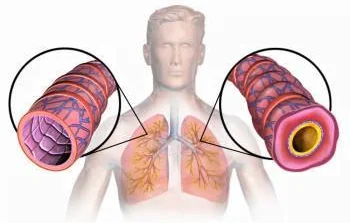
Overview
Acute bronchitis is inflammation of the windpipe (trachea) and the airways that branch off the trachea (bronchi) caused usually by a viral upper respiratory tract infection.
Symptoms are a cough that may or may not produce mucus (sputum).
The diagnosis is based primarily on symptoms.
Bronchitis can be either
- Acute – lasts for days to a few weeks.
- Chronic – lasts for months or years.
When people say “bronchitis,” they usually mean acute bronchitis, and only acute bronchitis is discussed here.
When people with chronic bronchitis have decreased airflow from the lungs when they breathe out (airflow obstruction), they are considered to have chronic obstructive pulmonary disease (COPD). If people who have COPD, or other chronic lung disorders such as bronchiectasis or cystic fibrosis, develop symptoms of acute bronchitis, doctors consider this a flare-up of the underlying disorder rather than acute bronchitis.
Do you know …
Coughing up yellow or green-coloured sputum does not mean the infection is caused by bacteria.
Acute bronchitis is usually treated best without using an antibiotic.
Acute bronchitis treated with Homeopathy can not only shorten the duration but also improves immunity and reduces the risk.
Homeopathic doses are perhaps the strongest.
Feodor Dostoevsky
Hey! You are almost there to start your treatment.
Causes of acute bronchitis
Acute bronchitis is caused by infection due to
- Viruses (most common) – Viral bronchitis may be caused by a number of common viruses, including the influenza virus and the viruses that cause the common cold. Acute bronchitis can also occur as part of the SARS-CoV-2 infection. Even after a viral infection has cleared up, the irritation it causes can continue to cause symptoms for weeks.
- Bacteria – Bacteria cause less than one in 20 cases of bronchitis. Mycoplasma pneumoniae, Chlamydia pneumoniae, and Bordetella pertussis infection (which causes whooping cough) are among the bacteria that cause acute bronchitis. Bacterial causes of acute bronchitis are more likely when many people in the same area are affected at the same time (an outbreak).
Occurs most often during the winter.
Cough in adults has many causes besides acute bronchitis. Cough in children has similar causes as in adults.
Symptoms of acute bronchitis
Infections causing acute bronchitis typically begin with the symptoms of a common cold: runny nose, sore throat, and fatigue. In addition, in people with COVID-19, fever, muscle aches, gastrointestinal symptoms, and loss of smell and taste are more common. After several days, cough begins (usually dry at first). People may cough up small amounts of thin, white mucus. This mucus often changes from white to green or yellow and becomes thicker. Occasionally, the sputum contains a small amount of blood. Neither the color change nor the presence of blood indicates there is a bacterial infection. Color change means only that cells associated with inflammation have moved into the airway and are coloring the sputum.
People do not usually have a high fever or chills unless this was caused by a more serious infection such as influenza.
Because bronchitis can temporarily narrow the airways, people may develop wheezing and/or shortness of breath, similar to what happens in an asthma attack.
Acute bronchitis itself does not cause serious complications. However, some infections that cause bronchitis such as influenza can lead to infection of the lung tissue (pneumonia), usually only in people who are older or who have problems with immune defenses.
Diagnosis of acute bronchitis
A doctor’s thorough evaluation which includes physical; mental; emotional; social health and environmental influence. Through this evaluation doctors try to identify the causes, factors modifying it and the impact on the daily life of a person.
Doctors usually make a diagnosis of acute bronchitis based on the symptoms. Doctors may do a chest x-ray to look for pneumonia if they hear congestion in the lungs, or if people have high or prolonged fever or shortness of breath.
Doctors rarely do tests to find the cause and blood tests are not helpful. However, in the current pandemic, testing for SARS-CoV2 may be done. Also, if a cough persists for more than 2 weeks, a chest x-ray is done to make sure that pneumonia has not developed, or a different lung disease is not causing the cough.
Doctors ask how the person feels; eats; sleeps and goes through a routine day. Identifying these changes is critical because they can make the situation better or worse and, if present, must be treated.
Homeopathic Treatment of acute bronchitis
After a thorough evaluation, each case is worked upon and a set of similar medicines is derived, from which one single medicine which fits the patient’s presentation at that time, in relevant intensity and repetitions is given.
Some need only one medicine throughout the duration of treatment and some need few in sequence one after another across the treatment.
Timely follow-ups are essential to keep moving forward towards the goal of treatment and to identify, manage and overcome any obstacles to the outcome.
Outcome of Customized Homeopathic treatment
With Individualized Homeopathic treatment focused on the person who is suffering, the outlook is as follows:
- Relieves cough
- Boosts metabolism
- Improves sleep
- Improves immunity
- Relieves fatigue
- Restores function
- Better moods
- Improves quality of life
Each person is unique and hence the time taken for treatment and the results achieved are also unique.
Try to consult a well-qualified professional homeopath who practices adhering to the tenets of Hahnemannian Homeopathy for Best Outcomes.